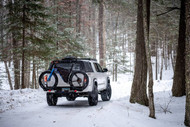What are the Different Types of Bike Racks? Your Complete Guide to Choosing the Right Bicycle Rack
Posted by 1UP USA on Oct 4th 2025

WHAT ARE THE DIFFERENT TYPES OF BIKE RACKS: YOUR COMPLETE GUIDE
Choosing the right bicycle rack can feel overwhelming with so many options available. From roof-mounted carriers to hitch-mounted trays, each type serves different needs and vehicles. This guide breaks down everything you need to know about the different types of bike racks, helping you make the best choice for your cycling adventures.
THE MAIN CATEGORIES OF BIKE RACKS
Bike racks fall into three primary categories based on where they attach to your vehicle: roof racks, trunk-mounted racks, and hitch-mounted racks. Each has advantages and works better for certain situations.
Roof racks attach to your vehicle's roof using crossbars. They come in two main styles: fork-mount and wheel-mount systems.
FORK-MOUNT ROOF RACKS
These racks require you to remove your bike's front wheel and secure the bike by its fork. They provide excellent stability and work with virtually any bike type, from road bikes to hardtail mountain bikes with different frame geometries.
WHEEL-MOUNT ROOF RACKS
Also called upright racks, these hold your bike by both wheels, keeping it complete. They're easier to load since you don't need to remove any parts, making them popular for quick stops during long rides on unpaved roads or gravel roads. The front tire and rear wheel remain attached, maintaining easy access to your complete bike.
Pros:
• Keeps your bike completely out of the way
• No impact on vehicle access or visibility
• Great for different types of bikes, including those with wider tires
• Doesn't affect ground clearance for rough terrain adventures
Cons:
• Requires lifting bikes overhead
• Height restrictions in garages and drive-throughs
• Can impact fuel economy due to wind resistance
• More expensive when factoring in crossbar systems
TRUNK-MOUNTED BIKE RACKS
These racks strap directly to your vehicle's trunk or rear hatch using hooks and straps. They're the most budget-friendly option and work on many vehicles without permanent modifications.
Pros:
• Most affordable option
• Easy installation without tools
• Works on vehicles without hitch receivers
Cons:
• Limited bike capacity (usually 2-3 bikes)
• Can scratch vehicle paint if not properly padded
• Less stable than other options
• Weight limits are typically lower
• May interfere with rear rack or spare tire access
Hitch racks slide into your vehicle's trailer hitch and offer the most versatility and stability. They come in two main styles: hanging and platform (tray) designs. The hitch mount system provides superior strength compared to other bicycle rack attachment methods.
UNDERSTANDING HITCH SIZES AND COMPATIBILITY
Before diving into hitch rack types, it's important to understand hitch sizes, as this determines which racks will fit your vehicle.
Hitch Size | Common Vehicles | Typical Towing Capacity |
1.25" | Sedans, compact SUVs, crossovers | Up to 2,000 lbs |
2" | Full-size SUVs, trucks, larger vehicles | 3,500-10,000 lbs |
2.5" | Heavy-duty trucks, commercial vehicles | 10,000+ lbs |
Most sedans and compact SUVs use 1.25" hitches, while larger vehicles typically have 2" receivers. The 2.5" size is becoming more common on three-quarter-ton and larger trucks.
HITCH-MOUNTED RACK STYLES
HANGING BIKE RACKS
Hanging racks suspend bikes from their top tubes or the bike's frame. They're typically more affordable than platform racks but have some limitations.
Pros:
• Lower cost than platform racks
• Lightweight and easy to handle
• Good for standard bike frames
Cons:
• Bikes can sway and contact each other
• Difficult to use with step-through frames or unusual geometries
• May scratch the bike's frame at contact points
• Less stable for heavier bikes
PLATFORM (TRAY) BIKE RACKS
Platform racks support bikes by their wheels, similar to how you'd park a bike. This design offers superior stability and works with any bike type.
Benefits of Platform Design:
• Accommodates any frame geometry
• Only touches tires and doesn't damage the bike's frame
• Individual bike support prevents contact between bikes
• Easier loading for heavy bikes
• More stable during transport
• Maintains easy access to your bike's components
SPECIALIZED RACK FEATURES TO CONSIDER
WEIGHT CAPACITY CONSIDERATIONS
Different racks handle varying weights, which becomes important when transporting mountain bikes, bikes with an electric motor, or cargo bikes carrying a heavy load.
• Standard racks: 35-50 lbs per bike (ideal for road bikes and hybrid bikes)
• Heavy-duty options: 50-60 lbs per bike (handles most mountain biking gear)
• Ultra-heavy-duty: 100+ lbs per bike for electric bikes and cargo bikes
TIRE CLEARANCE
Modern bikes come with wider tires, especially gravel bikes and mountain bikes. Different types of bikes require specific clearances:
• Road bike tires: 23-32mm (standard road cycling)
• Gravel bike tires: 35-45mm (for gravel roads and mixed terrain)
• Mountain bike tires: 2.0-2.5" (including 27.5-inch wheels)
• Fat bike tires: 3.5-5" (for extreme terrain and snow)
ACCESSIBILITY FEATURES
Racks that tilt or swing away from your vehicle allow rear access without removing bikes. This feature proves valuable for accessing your trunk, tailgate, or rear rack during trips. Many hitch mounts offer this easy access functionality or you can find hitch attachments to add this ability to a regular rack.
CHOOSING BETWEEN RACK TYPES: THREE KEY QUESTIONS
When selecting a bike rack, ask yourself these three questions:
1. WHAT VEHICLE WILL YOU USE?
Your vehicle determines which rack types are possible. Sedans might only accommodate roof or trunk racks, while SUVs and trucks open up hitch-mounted options. Consider whether you'll use the rack on multiple vehicles with different configurations.
2. WHAT TYPES OF BIKES WILL YOU TRANSPORT?
The bikes you own significantly impact your choice:
• Road bikes: Lightweight, narrow tires, compatible with most rack types, often feature caliper brakes or rim brakes
• Mountain bikes: Heavier, wider tires, benefit from stable platform designs, typically equipped with hydraulic disc brakes
• Electric bikes: Heavy (often 50-80 lbs), require high-capacity racks, electric motor adds weight
• Gravel bikes: Medium weight with wider tires than road bikes, designed for gravel roads and mixed terrain
• Hybrid bikes: Versatile city bikes with flat handlebars, moderate weight make them compatible with most rack types
• Cruiser bikes: Comfortable bikes for casual riding, often with heavier frame geometry
• BMX bikes: Specialized for bicycle motocross, unique frame design
• Cyclocross bikes: Racing bikes designed for mixed terrain and obstacles
3. WHAT TYPE OF DRIVING WILL YOU DO?
Your driving habits affect which rack features matter most:
• Pavement only: Standard racks work fine for smooth road surfaces and minimal vibration
• Gravel roads: Need more stability and secure attachment for unpaved roads
• Off-road adventures: Require heavy-duty construction and enhanced stability for rough terrain
• Long-distance travel: Consider aerodynamics and fuel efficiency for extended trips
• Urban environments: Factor in clearance for tight spaces and motor vehicle traffic
• Steep hills: Ensure rack stability when climbing with a heavy load
RACK ACCESSORIES AND ADD-ONS
Many racks offer expansion options and accessories:
• Convert single-bike racks to multi-bike capacity
• Add-on trays for growing bike collections
Convenience Features:
• Wheel Savers for expensive road wheels or mountain bike wheels with carbon fiber rims
• EZ Pull handles for simpler vehicle access and rear wheel clearance
• Fat tire spacer kits for wider tire clearance on different types of bikes
• Wheel chocks for extra stability with heavy bikes or when navigating steep hills
• Locking mechanisms to secure bikes to rack
• Hitch locks to prevent rack theft
SPECIAL CONSIDERATIONS FOR DIFFERENT BIKE TYPES
ELECTRIC BIKES
Electric bikes present unique challenges due to their weight and components. The electric motor and battery pack significantly increase the weight, often putting these bikes in the 50-80 pound range. Look for racks specifically rated for electric bike weights and consider models with enhanced stability features for long-distance transport.
CARBON FIBER BIKES
If you own a carbon fiber road bike or mountain bike, frame protection becomes a priority. Platform racks that only contact tires eliminate the risk of clamping damage to delicate carbon frames.
BIKES WITH DISC BRAKES
Most modern mountain bikes and many road bikes feature disc brakes instead of traditional rim brakes or cantilever brakes. Ensure your rack accommodates the disc brake rotor positioning and doesn't interfere with hydraulic disc brakes, brake pads, or the brake lever mechanism. Platform racks typically provide better clearance for disc brake systems than hanging styles.
BMX BIKES AND UNUSUAL GEOMETRIES
BMX bikes and some city bikes have unique frame geometries that can challenge traditional hanging racks. Commuter bikes with step-through frames, cruiser bikes with relaxed geometry, and specialized time trial bikes may not fit properly in hanging-style systems. Tray-style racks accommodate these different frame designs more easily, regardless of frame geometry or bike type.
INSTALLATION AND MAINTENANCE TIPS
PROPER INSTALLATION
Regardless of which type you choose, proper installation prevents damage and ensures safety:
• Follow manufacturer torque specifications for trailer hitch attachments
• Check all connections before each trip
• Ensure proper fit between the bicycle rack and hitch receiver
• Test stability before loading bikes
REGULAR MAINTENANCE
Keep your rack functioning smoothly:
• Clean moving parts regularly, especially after gravel roads, unpaved roads, or off-road use
• Lubricate pivot points and adjustment mechanisms
• Inspect for wear, particularly on contact points and brake lever clearances
• Check that front tire contact points aren't affecting your inner tube or tire integrity
• Store properly during off-seasons to prevent weather damage
REPLACEMENT PARTS
Quality racks should offer replacement parts. This feature extends the life of your investment significantly compared to cheaper alternatives that require complete replacement when components wear out.
SPECIAL CONSIDERATIONS FOR DIFFERENT BIKE TYPES
The best bike rack balances your specific needs with your budget. Consider these factors:
For occasional cyclists with standard bikes: A basic roof rack suffice for weekend rides on bike lanes.
For serious mountain bikers with valuable bikes: Invest in a quality platform rack that protects your investment during transport to rough terrain.
For multiple bike types or family use: Choose a versatile platform system with expansion options to handle everything from kids' bikes to adult mountain bikes.
For electric bike owners: Prioritize weight capacity and stability features to handle the electric motor weight safely.
For commuter bikes and city riding: Consider ease of loading and vehicle access for daily use in urban traffic.
Remember that a quality rack represents a long-term investment. While the initial cost might seem higher, a well-built rack with replaceable parts can last decades, unlike cheaper alternatives that require replacement every few years.
YOUR INVESTMENT IN ADVENTURE STARTS HERE
Understanding the different types of bike racks helps you make an informed decision that'll serve you well for years of cycling adventures. From lightweight road bikes to heavy electric bikes, there's a rack solution that fits your needs.
When you're ready to invest in a quality rack system, 1UP USA has you covered. Built in the US with replaceable parts and a lifetime warranty, our racks are designed to transport your bikes safely, whether you're heading to local bike trails or exploring the unbeaten path.
A great bike rack should disappear into the background: you load your bike, drive to your destination, and unload without giving it a second thought. That peace of mind is worth the investment in quality equipment that matches your specific needs.




